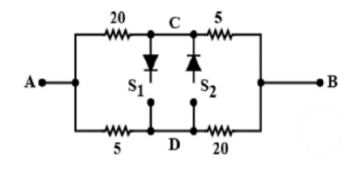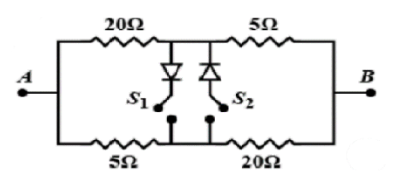Answer
414.6k+ views
Hint:An electric circuit and each component of the circuit are known as an element. The given circuit is connected from the resistance values $20\Omega $ and$5\Omega $.
The ideal diodes are connected from the ${S_{1{\text{ }}}}{\text{and }}{S_2}$ switches.
Complete step by step answer:
It is given ${V_A} > {V_B},$so current flows from A to B.
From the below figure when ${S_1}$ is open and ${S_2}$is closed
-The diode at ${S_2}$passes current only from D to C else zero current.
-If the current passes through the diode the voltage will be equal to D and C.
Let us assume that the D and C voltages are equal. Now we can short the ${S_2}$part.
Now in the equivalent circuit as$20\Omega > 5\Omega $current flows from D to C.
So it is satisfying the diode property.
Our circuit equivalent circuit will be the above circuit.
So the equivalent resistance $ = 2 \times \dfrac{1}{{\left( {\dfrac{1}{{20}} + \dfrac{1}{5}} \right)}}\Omega $
Here we have to take an LCM on the denominator term we get
$ = 2 \times \dfrac{1}{{\left( {\dfrac{{1 + 4}}{{20}}} \right)}}\Omega $
Let us add the term we get
$ = 2 \times \dfrac{1}{{\left( {\dfrac{5}{{20}}} \right)}}\Omega $
On dividing the term we get
$ = 2 \times \dfrac{1}{{\left( {\dfrac{1}{4}} \right)}}\Omega $
Taking reciprocal of the numerator term and multiply it we get,
$ = 8\Omega $
Now,${S_1}$ is closed and ${S_2}$is open
-The diode at ${S_1}$passes current only from C to D or else zero current.
- If current passes through the diode the voltage will be equal to D and C.
-Let us assume that the D and C voltage is equal. Now in the equivalent circuit as $20\Omega {\text{ > }}5\Omega $current has to flow from D to C. From D to C current does not allow. So our assumption is wrong.
We have to treat ${S_1}$as open.
The equivalent resistance is $ = \dfrac{{20 + 5}}{2}\Omega $
On adding the numerator term we get
$ = \dfrac{{25}}{2}\Omega $
Let us divide the term we get
$ = 12.5\Omega $
Additional information:
Potential difference, when the current flows between two points A and B of an electric circuit.

Where the aggregate resistance connected either in parallel or series is calculated, it is called equivalent resistance. Essentially, either in Series or Parallel is designed in the circuit
Note: A diode that acts like a perfect conductor, ideal diodes, when voltage is applied forward biased and like a perfect insulator, when voltage is applied reverse biased.
So the anode to the cathode when the positive voltage is applied across, the diode conducts forward current instantly.
The ideal diodes are connected from the ${S_{1{\text{ }}}}{\text{and }}{S_2}$ switches.
Complete step by step answer:
It is given ${V_A} > {V_B},$so current flows from A to B.
From the below figure when ${S_1}$ is open and ${S_2}$is closed
-The diode at ${S_2}$passes current only from D to C else zero current.
-If the current passes through the diode the voltage will be equal to D and C.
Let us assume that the D and C voltages are equal. Now we can short the ${S_2}$part.
Now in the equivalent circuit as$20\Omega > 5\Omega $current flows from D to C.
So it is satisfying the diode property.
Our circuit equivalent circuit will be the above circuit.
So the equivalent resistance $ = 2 \times \dfrac{1}{{\left( {\dfrac{1}{{20}} + \dfrac{1}{5}} \right)}}\Omega $
Here we have to take an LCM on the denominator term we get
$ = 2 \times \dfrac{1}{{\left( {\dfrac{{1 + 4}}{{20}}} \right)}}\Omega $
Let us add the term we get
$ = 2 \times \dfrac{1}{{\left( {\dfrac{5}{{20}}} \right)}}\Omega $
On dividing the term we get
$ = 2 \times \dfrac{1}{{\left( {\dfrac{1}{4}} \right)}}\Omega $
Taking reciprocal of the numerator term and multiply it we get,
$ = 8\Omega $
Now,${S_1}$ is closed and ${S_2}$is open
-The diode at ${S_1}$passes current only from C to D or else zero current.
- If current passes through the diode the voltage will be equal to D and C.
-Let us assume that the D and C voltage is equal. Now in the equivalent circuit as $20\Omega {\text{ > }}5\Omega $current has to flow from D to C. From D to C current does not allow. So our assumption is wrong.
We have to treat ${S_1}$as open.
The equivalent resistance is $ = \dfrac{{20 + 5}}{2}\Omega $
On adding the numerator term we get
$ = \dfrac{{25}}{2}\Omega $
Let us divide the term we get
$ = 12.5\Omega $
Additional information:
Potential difference, when the current flows between two points A and B of an electric circuit.

Where the aggregate resistance connected either in parallel or series is calculated, it is called equivalent resistance. Essentially, either in Series or Parallel is designed in the circuit
Note: A diode that acts like a perfect conductor, ideal diodes, when voltage is applied forward biased and like a perfect insulator, when voltage is applied reverse biased.
So the anode to the cathode when the positive voltage is applied across, the diode conducts forward current instantly.
Recently Updated Pages
How many sigma and pi bonds are present in HCequiv class 11 chemistry CBSE

Why Are Noble Gases NonReactive class 11 chemistry CBSE

Let X and Y be the sets of all positive divisors of class 11 maths CBSE

Let x and y be 2 real numbers which satisfy the equations class 11 maths CBSE

Let x 4log 2sqrt 9k 1 + 7 and y dfrac132log 2sqrt5 class 11 maths CBSE

Let x22ax+b20 and x22bx+a20 be two equations Then the class 11 maths CBSE

Trending doubts
Fill the blanks with the suitable prepositions 1 The class 9 english CBSE

At which age domestication of animals started A Neolithic class 11 social science CBSE

Which are the Top 10 Largest Countries of the World?

Give 10 examples for herbs , shrubs , climbers , creepers

Difference between Prokaryotic cell and Eukaryotic class 11 biology CBSE

Difference Between Plant Cell and Animal Cell

Write a letter to the principal requesting him to grant class 10 english CBSE

Change the following sentences into negative and interrogative class 10 english CBSE

Fill in the blanks A 1 lakh ten thousand B 1 million class 9 maths CBSE




